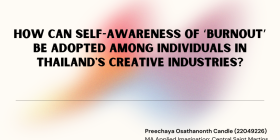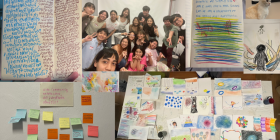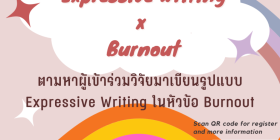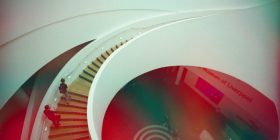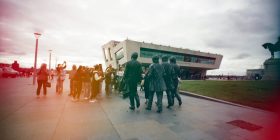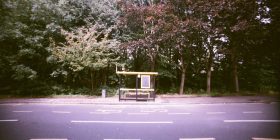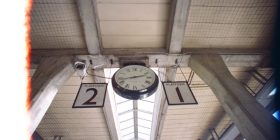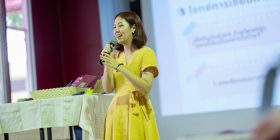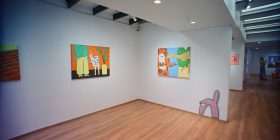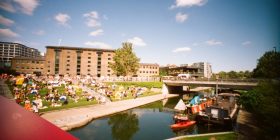Project Outline:
After studying Psychology at the degree level and working in creative industries in Thailand, I want to help people with my knowledge and use creativity for this project. People in this creative field have many mental health problems that they don’t realise, one of those problems being burnout. I want to provide interventions to help people who have burnout in this creative field in Thailand and identify suitable tools to help them have more self-awareness about burnout.
Introduction:
I surveyed people who work in creative industries in Thailand, and 99 people from 141 responses said they have burnout. Based on the findings from interviews conducted with individuals in the field, it can be observed that Thailand’s creative industries possess a distinct cultural identity. The hierarchical structure of job positions, power imbalances, unequal distribution of authority, age and generational disparities, and issues related to workload and compensation are not suitable. The tasks the client assigns need more creativity, necessitating additional work hours beyond regular working hours, including weekends. All of these can provide burnout. According to one of my interviewees, the experience of working in Paris is characterised by a greater emphasis on work-life balance, with a distinct boundary between professional and personal spheres. This research wants to focus on people working in Thailand’s creative industries.
Literature Review:
Burnout is a psychological syndrome that develops when employees endure persistent interpersonal stressors. An overpowering sense of exhaustion, detachment from the job, and a sensation of ineffectiveness and lack of accomplishment comprise the three essential components of this response. (Maslach and Leiter, 2016) For my research, the state of burnout is a response of both the body and mind to prolonged periods of stress, resulting in various symptoms. When talking about stress, people often perceive it as an emotional condition, but stress is a physiological state. The first burnout metric to be developed based on an extensive psychometric research programme was the Maslach Burnout Inventory (MBI). Subsequently, it became a General Survey (MBI‐GS) applicable to all occupations. As a result, I adhere to the Thai translation of MBI-GS as the criterion for selecting participants.
Self-awareness is the ability to perceive and understand the characteristics that define you as an individual (Cherry, 2023). In my interventions, I want my participants to have self-awareness about their burnout, which means they can know and define their state of burnout.
There are many ways to help people with burnout. Art therapy-based interventions (Ho et al., 2021; Moss et al., 2022) Numerous studies show that social support is vital to mental and physical health. A community of people provides psychological and material help to manage stress, which gives guidance, kindness, sympathy, or empathy. (2020 Cherry) Social support may reduce risk of hereditary and environmental mental illness by boosting effective coping and altering neurobiological components. (2007, Ozbay et al.) According to my survey, people desire to talk to others in the same industry, such as creatives with different companies and positions.
In the context of developing self-awareness, journaling aims to attain a more profound comprehension of oneself than ever before.
It is an opportunity to communicate with subconscious emotions that you might be neglecting or overlooking. Writing serves as a medium to express these sentiments, facilitating their illumination. (Life Skills That Matter, 2016) After-work reflective journaling could serve as a method to mitigate sensations of fatigue. As an intervention, reflective journaling has enhanced nurses’ self-awareness, compassion, fatigue, and exhaustion. (Langan and Keppen, 2022)
According to Cronin et al. (2020), Many writers strongly need to write their stories. Spending time on a hobby like creative writing can boost well-being and professional performance. Physicians can avoid burnout tension and rekindle their passion for medicine by being creative. Expressive writing can reduce stress, anxiety, and depression, improve sleep and performance, and improve focus and clarity. (Siegel-Acevedo, 2021)
My research will focus on art therapy, social connection, journaling, and expressive writing.
Methodology:
Using tools: art therapy, social support, journaling, and expressive writing for six interventions. The approach is inductive and multi-method, using the Maslach Burnout Inventory – General Survey (MBI-GS) for burnout criteria in art therapy workshops and expressive writing workshops asquantitative research. Still, most of my approaches are qualitative research. The mix ofstrategies: action research by doing interventions, surveying people in Thailand’s creative industries by questionnaires and interviews. Participants were recruited by snowball sampling. This is cross-sectional because I focused and gathered data on each intervention at a specific time.
Finding:
I did my first intervention in June, an art therapy for Thai creative industries people living in London who have burnout. A licenced art therapist ran the art therapy. He assisted me in developing the intervention approach and activities. The goals are to comprehend burnout, its consequences, and fundamental self-care solutions for burnout. The participants were then chosen based on the General Survey (MBI‐GS) (Kitaoka and Masuda, 2016), translated into Thai as inclusion criteria, and retook this MBI‐GS after finishing the workshop. The result shows the scores of each participant are not different, and some of them have higher burnout scores.
I learned from this workshop that what I wanted to do was not reduce their burnout but rather, make them more aware of it. The time that they took the pre-MBI‐GS and post-MBI‐GS is very close, so the score can be quite the same, and the after-art therapy workshop can make some people more aware of burnout, which is why they have a higher score than the pre-test. I decided not to use MBI-GS for the post-test again, but I will use open questions to ask them.
All the feedback is in this BLOG1.
I did my second and third interventions in Bangkok, Thailand, with the same art therapist. We developed and improved the art workshop that we did in London. We changed from three to four hours because participants from the first workshop said time was limited, and they had to do everything in a rush. According to the findings, most participants understood more about burnout and its causes. They have a greater understanding of their emotions, are more relaxed and soothed, and feel better than before the session.
I learned from the findings that individuals actively seek out secure space in order to engage in open conversations, share their thoughts, and connect with others who face similar problems. This desire for safe spaces stems from a fundamental need to establish a sense of common humanity.
All the feedback is in these BLOG2, BLOG3
The creative social night was the intervention that I did without burnout context. I wanted to focus more on results after I did a connection group talk within the creative industries—a sharing circle where people chatted about their jobs and life experiences.
I learned from this intervention that people enjoyed the talking and sharing experience part even though it is not about burnout, so it can show that people in these industries need space to talk and share, the same as the findings from art therapy workshops.
These two blogs are about the creative social night: BLOG4 , BLOG5.
My 5th intervention, the creative journal, was to write without being instructed and hosted an online gathering for all participants to meet, speak, and share their life and work experiences. The results surprised me. Some people did the journal for less than four days in those periods. Some of them prefer drawing/ collage to writing. Some people used iPads or iPhones to journal.
I learned that people have different ways of coping with themselves and expressing their feelings; it doesn’t have to be writing it down on paper or speaking with someone. They know that writing a journal can be one of the tools that can help them with their problem, but it is not fit for everyone. Also, about the networking session, they preferred onsite to online, which made me think that we can see physical interaction and eye contact during the onsite event, but these things can’t be shown in an online meeting. I learned that, if possible, onsite meetings can make them feel more connected and talk more openly.
All the feedback is in these BLOG6.
My last intervention was expressive writing on the topic of burnout. I focused more on awareness of burnout and whether people will adopt this tool after finishing the intervention. The intervention was conducted over four days, and participants could write at any time that day in their own time. After four days, I had a one-hour Zoom meeting with them and the therapist to catch up, provide feedback, do a Q&A, and give information on burnout. The findings show that most of them reported increasing their awareness of their burnout. They also suggested other tools they thought would be helpful, such as drawing pictures, doing art activities, and sharing experiences in the same field. Also, the critical question is whether they will adopt this writing in the future so that it will answer my research question. “Will you continue with Expressive Writing in the future?” One of them won’t continue. Two of them said, ‘Maybe’. Four of them will continue writing.
The evidence in my last intervention shows that one of the participants reported, “I probably won’t continue because I don’t enjoy journaling. I feel like I’ve figured out how to deal with my stress in other ways. I prefer talking to people more, so I think I’ll go in that direction instead.” So, she knows that expressive writing is not the right tool for her, but it helps her because she also reported, “Writing it out makes us aware of how we truly feel because the emotions flow out continuously. The more we write, the more we discover unusual things we’ve kept in our hearts.” (BLOG8)
I learned I can’t force anyone to do anything on time, as expected. It took a long time to receive the feedback form and the pictures from the participants I requested. This expressive writing is also unsuitable for everyone, like other tools I used before, and every tool is subjective. Even though they reported that this tool is helpful for them, that doesn’t mean they will continue using it in the future.
All the feedback is in these BLOG7, BLOG8.
Conclusion:
Intervention results can answer my research question. With my tools, self-awareness of burnout can be achieved in many ways. Individuals are subjective, people are different, so some tools work for some but not others. Creative people use different tools to raise awareness, depending on their preferences.
Some limitations can be improved; people prefer onsite activities, and some of my interventions were online, so it can improve to be onsite for more interaction and to observe more behaviours. Some interventions, such as journals, can be done for an extended period, and a longitudinal time horizon for data collection can be used so the research can show how people develop their thoughts and feelings through time changes.
Creating shared power space is the next step option: This space could facilitate empathetic sharing and elevate oppressed voices. This could involve subordinates speaking and superiors listening to foster mutual understanding. My expert, Wattanapume Laisuwanchai, suggests that organised pain-sharing sessions provide group support. People become more aware when they are able to express their feelings, share their experiences, and meet others who have faced similar challenges. This can help with the pain in industries like the hierarchical structure of job positions, power imbalances, unequal distribution of authority, age, and generational disparities.
Learn the thoughts, feelings, and processes of those who engage in the interventions, regardless of their outcome. Creative industries’ burnout reveals a deeper issue. Additionally, this problem has no unique solution. Future methods can be developed from the interventions.
Bibliography:
My Blog Candle: https://candle.myblog.arts.ac.uk/
Cherry, K. (2020). How Social Support Contributes to Psychological Health. [online] Verywell Mind. Available at: https://www.verywellmind.com/social-support-for-psychological-health-4119970.
Cherry, K. (2023). What Is Self-Awareness? [online] Verywell Mind. Available at: https://www.verywellmind.com/what-is-self-awareness-2795023.
Cronin, M., Hubbard, V., Cronin, T.A. and Frost, P. (2020). Combatting professional burnout through creative writing. Clinics in Dermatology, 38(5), pp.512–515. doi:https://doi.org/10.1016/j.clindermatol.2020.05.004.
Ho, A.H.Y., Tan-Ho, G., Ngo, T.A., Ong, G., Chong, P.H., Dignadice, D. and Potash, J. (2021). A Novel Mindful-Compassion Art-Based Therapy for Reducing Burnout and Promoting Resilience Among Healthcare Workers: Findings From a Waitlist Randomized Control Trial. Frontiers in Psychology, 12. doi:https://doi.org/10.3389/fpsyg.2021.744443.
Langan, B. and Keppen, K. (2022). Reflective Journaling Intervention to Impact Self-awareness, Professional Health, and Overall Well-being in Nurses. Doctor of Nursing Practice Projects: College of Nursing, [online] 10. Available at: https://digitalcommons.unmc.edu/con_dnp/10/?utm_source=digitalcommons.unmc.edu%2Fcon_dnp%2F10&utm_medium=PDF&utm_campaign=PDFCoverPages [Accessed 26 Oct. 2023].
Life Skills That Matter. (2016). Number One Self-Awareness Habit. [online] Available at: https://lifeskillsthatmatter.com/number-one-self-awareness-habit/.
Maslach, C. and Leiter, M.P. (2016). Understanding the Burnout experience: Recent Research and Its Implications for Psychiatry. World Psychiatry, [online] 15(2), pp.103–111. doi:https://doi.org/10.1002/wps.20311.
Moss, M., Edelblute, A., Sinn, H., Torres, K., Forster, J., Adams, T., Morgan, C., Henry, M. and Reed, K. (2022). The Effect of Creative Arts Therapy on Psychological Distress in Health Care Professionals. The American Journal of Medicine, [online] 135(10), pp.1255-1262.e5. doi:https://doi.org/10.1016/j.amjmed.2022.04.016.
Ozbay, F., Johnson, D.C., Dimoulas, E., Morgan, C.A., Charney, D. and Southwick, S. (2007). Social Support and Resilience to stress: from Neurobiology to Clinical Practice. Psychiatry (Edgmont), [online] 4(5), pp.35–40. Available at: https://www.ncbi.nlm.nih.gov/pmc/articles/PMC2921311/.
Siegel-Acevedo, D. (2021). Writing Can Help Us Heal from Trauma. [online] Harvard Business Review. Available at: https://hbr.org/2021/07/writing-can-help-us-heal-from-trauma.
Research Question: How can self-awareness of ‘burnout’ be adopted among individuals in Thailand’s creative industries?
Project Outline:
After studying Psychology at the degree level and working in creative industries in Thailand, I want to help people with my knowledge and use creativity for this project. People in this creative field have many mental health problems that they don’t realise, one of those problems being burnout. I want to provide interventions to help people who have burnout in this creative field in Thailand and identify suitable tools to help them have more self-awareness about burnout.
Introduction:
I surveyed people who work in creative industries in Thailand, and 99 people from 141 responses said they have burnout. Based on the findings from interviews conducted with individuals in the field, it can be observed that Thailand’s creative industries possess a distinct cultural identity. The hierarchical structure of job positions, power imbalances, unequal distribution of authority, age and generational disparities, and issues related to workload and compensation are not suitable. The tasks the client assigns need more creativity, necessitating additional work hours beyond regular working hours, including weekends. All of these can provide burnout. According to one of my interviewees, the experience of working in Paris is characterised by a greater emphasis on work-life balance, with a distinct boundary between professional and personal spheres. This research wants to focus on people working in Thailand’s creative industries.
Literature Review:
Burnout is a psychological syndrome that develops when employees endure persistent interpersonal stressors. An overpowering sense of exhaustion, detachment from the job, and a sensation of ineffectiveness and lack of accomplishment comprise the three essential components of this response. (Maslach and Leiter, 2016) For my research, the state of burnout is a response of both the body and mind to prolonged periods of stress, resulting in various symptoms. When talking about stress, people often perceive it as an emotional condition, but stress is a physiological state. The first burnout metric to be developed based on an extensive psychometric research programme was the Maslach Burnout Inventory (MBI). Subsequently, it became a General Survey (MBI‐GS) applicable to all occupations. As a result, I adhere to the Thai translation of MBI-GS as the criterion for selecting participants.
Self-awareness is the ability to perceive and understand the characteristics that define you as an individual (Cherry, 2023). In my interventions, I want my participants to have self-awareness about their burnout, which means they can know and define their state of burnout.
There are many ways to help people with burnout. Art therapy-based interventions (Ho et al., 2021; Moss et al., 2022) Numerous studies show that social support is vital to mental and physical health. A community of people provides psychological and material help to manage stress, which gives guidance, kindness, sympathy, or empathy. (2020 Cherry) Social support may reduce risk of hereditary and environmental mental illness by boosting effective coping and altering neurobiological components. (2007, Ozbay et al.) According to my survey, people desire to talk to others in the same industry, such as creatives with different companies and positions.
In the context of developing self-awareness, journaling aims to attain a more profound comprehension of oneself than ever before.
It is an opportunity to communicate with subconscious emotions that you might be neglecting or overlooking. Writing serves as a medium to express these sentiments, facilitating their illumination. (Life Skills That Matter, 2016) After-work reflective journaling could serve as a method to mitigate sensations of fatigue. As an intervention, reflective journaling has enhanced nurses’ self-awareness, compassion, fatigue, and exhaustion. (Langan and Keppen, 2022)
According to Cronin et al. (2020), Many writers strongly need to write their stories. Spending time on a hobby like creative writing can boost well-being and professional performance. Physicians can avoid burnout tension and rekindle their passion for medicine by being creative. Expressive writing can reduce stress, anxiety, and depression, improve sleep and performance, and improve focus and clarity. (Siegel-Acevedo, 2021)
My research will focus on art therapy, social connection, journaling, and expressive writing.
Methodology:
Using tools: art therapy, social support, journaling, and expressive writing for six interventions. The approach is inductive and multi-method, using the Maslach Burnout Inventory – General Survey (MBI-GS) for burnout criteria in art therapy workshops and expressive writing workshops asquantitative research. Still, most of my approaches are qualitative research. The mix ofstrategies: action research by doing interventions, surveying people in Thailand’s creative industries by questionnaires and interviews. Participants were recruited by snowball sampling. This is cross-sectional because I focused and gathered data on each intervention at a specific time.
Finding:
I did my first intervention in June, an art therapy for Thai creative industries people living in London who have burnout. A licenced art therapist ran the art therapy. He assisted me in developing the intervention approach and activities. The goals are to comprehend burnout, its consequences, and fundamental self-care solutions for burnout. The participants were then chosen based on the General Survey (MBI‐GS) (Kitaoka and Masuda, 2016), translated into Thai as inclusion criteria, and retook this MBI‐GS after finishing the workshop. The result shows the scores of each participant are not different, and some of them have higher burnout scores.
I learned from this workshop that what I wanted to do was not reduce their burnout but rather, make them more aware of it. The time that they took the pre-MBI‐GS and post-MBI‐GS is very close, so the score can be quite the same, and the after-art therapy workshop can make some people more aware of burnout, which is why they have a higher score than the pre-test. I decided not to use MBI-GS for the post-test again, but I will use open questions to ask them.
All the feedback is in this BLOG1.
I did my second and third interventions in Bangkok, Thailand, with the same art therapist. We developed and improved the art workshop that we did in London. We changed from three to four hours because participants from the first workshop said time was limited, and they had to do everything in a rush. According to the findings, most participants understood more about burnout and its causes. They have a greater understanding of their emotions, are more relaxed and soothed, and feel better than before the session.
I learned from the findings that individuals actively seek out secure space in order to engage in open conversations, share their thoughts, and connect with others who face similar problems. This desire for safe spaces stems from a fundamental need to establish a sense of common humanity.
All the feedback is in these BLOG2, BLOG3
The creative social night was the intervention that I did without burnout context. I wanted to focus more on results after I did a connection group talk within the creative industries—a sharing circle where people chatted about their jobs and life experiences.
I learned from this intervention that people enjoyed the talking and sharing experience part even though it is not about burnout, so it can show that people in these industries need space to talk and share, the same as the findings from art therapy workshops.
These two blogs are about the creative social night: BLOG4 , BLOG5.
My 5th intervention, the creative journal, was to write without being instructed and hosted an online gathering for all participants to meet, speak, and share their life and work experiences. The results surprised me. Some people did the journal for less than four days in those periods. Some of them prefer drawing/ collage to writing. Some people used iPads or iPhones to journal.
I learned that people have different ways of coping with themselves and expressing their feelings; it doesn’t have to be writing it down on paper or speaking with someone. They know that writing a journal can be one of the tools that can help them with their problem, but it is not fit for everyone. Also, about the networking session, they preferred onsite to online, which made me think that we can see physical interaction and eye contact during the onsite event, but these things can’t be shown in an online meeting. I learned that, if possible, onsite meetings can make them feel more connected and talk more openly.
All the feedback is in these BLOG6.
My last intervention was expressive writing on the topic of burnout. I focused more on awareness of burnout and whether people will adopt this tool after finishing the intervention. The intervention was conducted over four days, and participants could write at any time that day in their own time. After four days, I had a one-hour Zoom meeting with them and the therapist to catch up, provide feedback, do a Q&A, and give information on burnout. The findings show that most of them reported increasing their awareness of their burnout. They also suggested other tools they thought would be helpful, such as drawing pictures, doing art activities, and sharing experiences in the same field. Also, the critical question is whether they will adopt this writing in the future so that it will answer my research question. “Will you continue with Expressive Writing in the future?” One of them won’t continue. Two of them said, ‘Maybe’. Four of them will continue writing.
The evidence in my last intervention shows that one of the participants reported, “I probably won’t continue because I don’t enjoy journaling. I feel like I’ve figured out how to deal with my stress in other ways. I prefer talking to people more, so I think I’ll go in that direction instead.” So, she knows that expressive writing is not the right tool for her, but it helps her because she also reported, “Writing it out makes us aware of how we truly feel because the emotions flow out continuously. The more we write, the more we discover unusual things we’ve kept in our hearts.” (BLOG8)
I learned I can’t force anyone to do anything on time, as expected. It took a long time to receive the feedback form and the pictures from the participants I requested. This expressive writing is also unsuitable for everyone, like other tools I used before, and every tool is subjective. Even though they reported that this tool is helpful for them, that doesn’t mean they will continue using it in the future.
All the feedback is in these BLOG7, BLOG8.
Conclusion:
Intervention results can answer my research question. With my tools, self-awareness of burnout can be achieved in many ways. Individuals are subjective, people are different, so some tools work for some but not others. Creative people use different tools to raise awareness, depending on their preferences.
Some limitations can be improved; people prefer onsite activities, and some of my interventions were online, so it can improve to be onsite for more interaction and to observe more behaviours. Some interventions, such as journals, can be done for an extended period, and a longitudinal time horizon for data collection can be used so the research can show how people develop their thoughts and feelings through time changes.
Creating shared power space is the next step option: This space could facilitate empathetic sharing and elevate oppressed voices. This could involve subordinates speaking and superiors listening to foster mutual understanding. My expert, Wattanapume Laisuwanchai, suggests that organised pain-sharing sessions provide group support. People become more aware when they are able to express their feelings, share their experiences, and meet others who have faced similar challenges. This can help with the pain in industries like the hierarchical structure of job positions, power imbalances, unequal distribution of authority, age, and generational disparities.
Learn the thoughts, feelings, and processes of those who engage in the interventions, regardless of their outcome. Creative industries’ burnout reveals a deeper issue. Additionally, this problem has no unique solution. Future methods can be developed from the interventions.
Bibliography:
Cherry, K. (2020). How Social Support Contributes to Psychological Health. [online] Verywell Mind. Available at: https://www.verywellmind.com/social-support-for-psychological-health-4119970.
Cherry, K. (2023). What Is Self-Awareness? [online] Verywell Mind. Available at: https://www.verywellmind.com/what-is-self-awareness-2795023.
Cronin, M., Hubbard, V., Cronin, T.A. and Frost, P. (2020). Combatting professional burnout through creative writing. Clinics in Dermatology, 38(5), pp.512–515. doi:https://doi.org/10.1016/j.clindermatol.2020.05.004.
Ho, A.H.Y., Tan-Ho, G., Ngo, T.A., Ong, G., Chong, P.H., Dignadice, D. and Potash, J. (2021). A Novel Mindful-Compassion Art-Based Therapy for Reducing Burnout and Promoting Resilience Among Healthcare Workers: Findings From a Waitlist Randomized Control Trial. Frontiers in Psychology, 12. doi:https://doi.org/10.3389/fpsyg.2021.744443.
Langan, B. and Keppen, K. (2022). Reflective Journaling Intervention to Impact Self-awareness, Professional Health, and Overall Well-being in Nurses. Doctor of Nursing Practice Projects: College of Nursing, [online] 10. Available at: https://digitalcommons.unmc.edu/con_dnp/10/?utm_source=digitalcommons.unmc.edu%2Fcon_dnp%2F10&utm_medium=PDF&utm_campaign=PDFCoverPages [Accessed 26 Oct. 2023].
Life Skills That Matter. (2016). Number One Self-Awareness Habit. [online] Available at: https://lifeskillsthatmatter.com/number-one-self-awareness-habit/.
Maslach, C. and Leiter, M.P. (2016). Understanding the Burnout experience: Recent Research and Its Implications for Psychiatry. World Psychiatry, [online] 15(2), pp.103–111. doi:https://doi.org/10.1002/wps.20311.
Moss, M., Edelblute, A., Sinn, H., Torres, K., Forster, J., Adams, T., Morgan, C., Henry, M. and Reed, K. (2022). The Effect of Creative Arts Therapy on Psychological Distress in Health Care Professionals. The American Journal of Medicine, [online] 135(10), pp.1255-1262.e5. doi:https://doi.org/10.1016/j.amjmed.2022.04.016.
Ozbay, F., Johnson, D.C., Dimoulas, E., Morgan, C.A., Charney, D. and Southwick, S. (2007). Social Support and Resilience to stress: from Neurobiology to Clinical Practice. Psychiatry (Edgmont), [online] 4(5), pp.35–40. Available at: https://www.ncbi.nlm.nih.gov/pmc/articles/PMC2921311/.
Siegel-Acevedo, D. (2021). Writing Can Help Us Heal from Trauma. [online] Harvard Business Review. Available at: https://hbr.org/2021/07/writing-can-help-us-heal-from-trauma.



